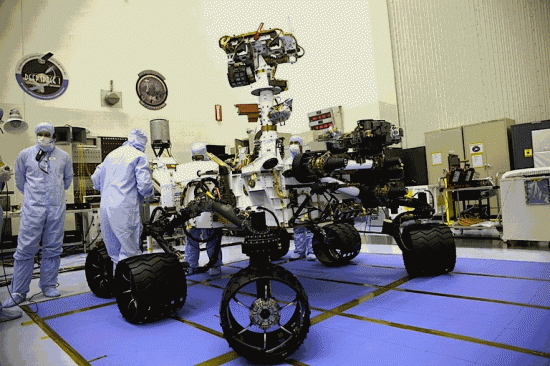
The Mars Science Laboratory is a much larger rover than its predecessors. Credit: NASA/Frankie Martin
August 06, 2012
The Mars rover Curiosity is on schedule for touchdown at 12:31 AM CDT on August 6, 2012.
Curiosity is five times heavier than the Mars Exploration Rovers “Opportunity” and “Spirit,” with upgraded instrumentation, including a high definition stereo video camera. Additionally, a tunable laser spectrometer can identify a wide range of organic compounds, as well as determine the isotopes of different key elements.
Curiosity will have one chance to successfully land on Mars. It will not enter orbit. Instead, it will enter the Martian atmosphere at its cruise velocity of 21,400 kilometers per hour, protected by a heat shield. It will then deploy a parachute 16 meters in diameter once it slows sufficiently. The parachute is designed to withstand deployment at over 29,000 kilograms of drag force, well above what will be sustained in the Martian atmosphere. A descent motor will fire, slowing the spacecraft until it is hovering over the surface, whereupon a crane will lower the rover into the landscape.
Curiosity’s objective is to search for life, or evidence of previous life, on Mars. The space program has been working on that project since the early 1970s when Viking 1 was launched from Cape Canaveral on August 20, 1975, followed one month later by Viking 2. On July 20, 1976 Viking 1 landed on Mars, preceding its twin by almost exactly six weeks.
The essential reason for the Viking landers was to look for the same things that the MSL is designed to look for. Viking 1 landed in the western portion of Chryse Planitia, while Viking 2 landed 6700 kilometers away in Utopia Planitia. Both landers analyzed soil samples in an attempt to locate respiratory byproducts, but nothing conclusive was found.
The air is 100 times thinner on Mars and averages 75 degrees colder than Earth. The environment appears to be bone dry, with only some suggestive experiments by the Phoenix lander to indicate the possible presence of water ice. Without the presence of water in the form of subsurface ice deposits, the chances of finding life are admitted by all concerned to be slim.
In 1997, the Mars Global Surveyor (MGS) found outcrops of layered rock extending for thousands of kilometers. Hundreds more images uncovered rock layering in other locations. Since many of the layers are similar in thickness, NASA scientists conclude that the strata are sedimentary. They might have built-up in water and then been eroded by wind. For that reason, Curiosity’s landing site is in an area that is extensively layered.
The active electrical forces that almost destroyed Mars at some time in the recent past are, of course, ignored by consensus science. Until electromagnetic forcefields, plasma discharges, and double layers are studied and understood by planetary scientists, no theory about Mars will be satisfactory.
Mars tells a story that includes powerful plasma discharges on a massive scale. Vast areas show signs of excavation down to six kilometers below the mean elevation. Some of the shattered rock was accelerated electrically into space; some fell back to the surface, where it was electrically sorted and deposited in hardened layers. Rather than water, it was probably lightning that layered Mars.
Stephen Smith
Footnote: As of 12:40 AM CDT August 6, 2012, 4 images from Curiosity have been received. The rover is alive and on Mars.












